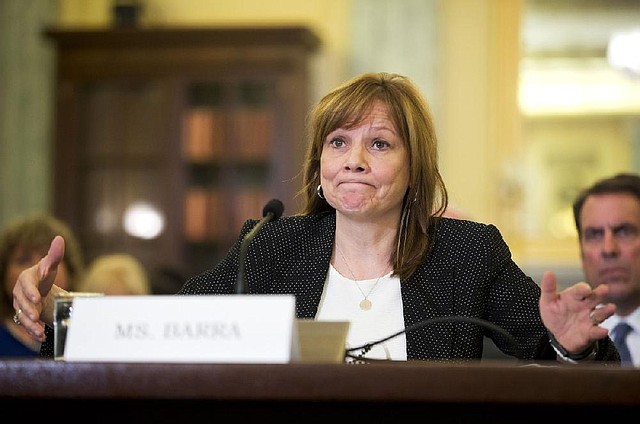Documents show GM hid crash data from agency
Mary Barra, chief executive officer of General Motors, testifi es about problems with the company’s vehicles on Capitol Hill in April. She and other GM officials are likely to face intense scrutiny again Thursday at a Senate hearing.
Wednesday, July 16, 2014
The car crash that killed Gene Erickson caught the attention of federal regulators. Why did the Saturn Ion he was traveling in, along a rural Texas road, suddenly swerve into a tree? Why did the air bags fail? General Motors told federal authorities that it could not provide answers.
But only a month earlier, a GM engineer had concluded in an internal evaluation that the Ion had most likely lost power, disabling its air bags, according to a subsequent internal investigation commissioned by GM.
Now, GM's response, as well as its replies to queries regarding other crashes obtained by The New York Times from the National Highway Traffic Safety Administration, casts doubt on how forthright the automaker was with regulators about a defective ignition switch that GM has linked to at least 13 deaths in the past decade.
They provide details for the first time on the issue at the heart of a criminal investigation by the Justice Department: whether GM, in its interaction with safety regulators, obscured a deadly defect that would also injure perhaps hundreds of people.
The company repeatedly found a way not to answer the simple question from regulators of what led to a crash. In at least three cases of fatal crashes, including the accident that killed Erickson, GM said that it had not assessed the cause. In another fatal crash, GM said that attorney-client privilege may have prevented it from answering.
And in other cases, the automaker was more blunt, writing, "GM opts not to respond."
The responses came even though GM had for years been aware of sudden power loss in some models involved in the accidents.
The responses are found in documents known as death inquiries, which the Times obtained through the Freedom of Information Act. In those inquiries, regulators ask automakers to explain the circumstances surrounding a crash to help identify potential defects in cars.
On Thursday, the head of GM's legal department, Michael Millikin, is expected to face intense scrutiny before lawmakers at a Senate hearing. He is to testify along with Mary Barra, the company's chief executive officer, who faced a harsh grilling before the same panel in April.
The Times asked the safety agency for death inquiries related to fatal crashes in older Chevrolet Cobalts and Saturn Ions, which are among the 2.6 million cars with defective ignition switches that GM has recalled since February. Of the 13 deaths linked to the defect, all of which involved Cobalts and Ions, the Times received inquiries for four of them.
Erickson was riding in the front seat of a Saturn Ion driven by Candice Anderson in 2004. They were an hour from Dallas when the car suddenly drove into a tree, killing Erickson but sparing Anderson. Only recently did Anderson, who pleaded guilty to criminally negligent homicide after the accident because she had a trace of Xanax in her system, learn that she was not to blame.
Despite the earlier determination by the engineer, Manuel Peace, that the engine's shutting off had most likely been the reason for the crash, GM, in its response to regulators, said there may not have been "sufficient reliable information to accurately assess the cause" of the accident.
GM, which also faced a lawsuit from Erickson's family at the time, further stated that attorney-client privilege may have been a reason it could not make any disclosures.
Ultimately, GM said it had not assessed the cause of the accident.
"It seems inconsistent," said Carl Tobias, a law professor at the University of Richmond, who specializes in product liability. "It seems like the company knew that the accident was attributable to power loss. It does sound like they didn't give NHTSA everything they should have. That could make them vulnerable to the Justice Department's investigation."
When asked about GM's responses to the government's death inquiries, James Cain, a spokesman, said Tuesday: "We are confronting our problems openly and directly. We are taking responsibility for what has happened and making significant changes across our company to make sure that it never happens again."
In a later death inquiry, GM chose not to say whether it had looked into the circumstances of the December 2009 crash in Tennessee that killed Seyde Chansuthus. GM added in its response that any privileged material related to the case would not be shared, even though it had not been sued by Chansuthus' family at the time.
But there had already been a thorough review of Chansuthus' accident within GM.
GM's reluctance to respond to the government with evaluations of suspicious crashes extended beyond just the accidents that the automaker has publicly linked to its ignition defect.
Several fatal crashes -- including those of Benjamin Hair, 20, in Virginia, and Amy Kosilla, 23, in New York -- also had death inquiries. In both those cases, when asked to explain why the vehicles had driven straight off the road -- with front-impacts and no air bag deployment -- the automaker took advantage of the optional nature of the question and did not reply.
Death inquiries date back to the late 1990s, when the safety agency was criticized for failing to spot highway rollovers in Ford Explorers with Firestone tires, a problem eventually tied to 271 deaths.
A Section on 07/16/2014

